Multifunctionality is their trademark, their sharpness is legendary, so is their durability. Implemented as promotional products, the Swiss army knives of Victorinox are more than typical Swiss precision work: They stand for a high emotional bond, character, design and history.
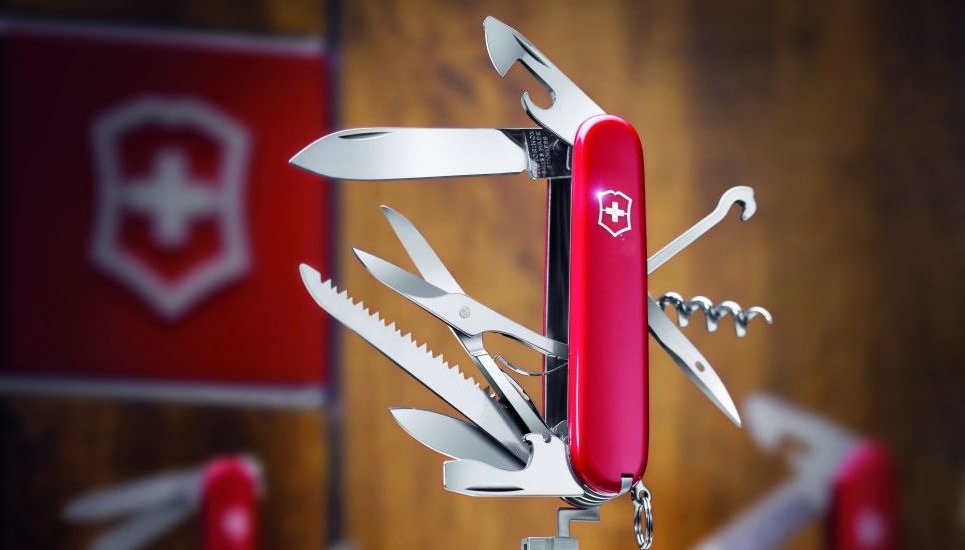
For instance, there’s the story of Gilbert V. Levin, who had his coveted Swiss army knife returned to him after four years in almost exactly the same condition after he had dropped it into a sewage plant and it had been retrieved during an inspection of the bottom of the treatment tank. Or the one about the NASA astronaut, Chris Hadfield, who opened the hatch of the space shuttle Atlantis with a Swiss army knife in order to dock on to the space station Mir and thus saved the mission. Afterwards, he recommended that nobody should ever leave earth without a Victorinox pocketknife.
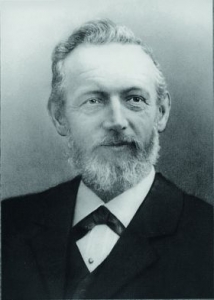
Victorinox founder Karl Elsener wanted to create jobs in the region Schwyz .
Such and similar stories – all of which are factual accounts that Victorinox has summarised in the book A companion for life – have significantly contributed towards the cult character of the brand, however they only account for part of the fascination that surrounds the Swiss traditional label. The long-standing company history, the literally Swiss-made quality, the production in the company’s own knife factory in Ibach in the Schwyz Canton, their huge success abroad – Victorinox knives are exported to 120 countries – are further factors. Yet, it is not least the unique corporate philosophy that distinguishes the company. A philosophy, which relies on long-term success and not on profit maximisation. Since the company was founded in 1884 through to this very day, it has always been run by a Karl or Carl Elsener. However, in the year 2000 the family completely waivered its legal claim to the inheritance, writing the share capital over to two foundations, which on the one hand secures the continued existence of the company and on the other hand in order to support other charity aid projects.
A special spirit characterises the company, which is not only perceived by the employees, but also by the customers. Anyone, who buys a Victorinox knife, also buys this identity. “The emotional value of a Victorinox knife is immense,” added Hans-Rudolf Steiner, Head of Marketing & Sales B2B at Victorinox, who, like quite a few other members of staff, has been working for the Swiss knife manufacturer for over three decades. “Many knives not only last a lifetime, they are indeed even passed on to further generations. This attachment to the product and the brand is, of course, very helpful for our advertising measures.“
Success story
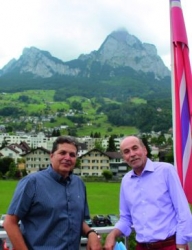
The Media Director Hans Schorno (l) and Hans-Rudolf Steiner, Head of Marketing & Sales B2B.
The Victorinox history dates back to the end of the 19 Century in Switzerland. Poverty and rural migration prevailed. So, the cutler Karl Elsener decided to found a knife factory to create jobs in his home town. “This social aspect of the creation and safeguarding of jobs was one of the main motifs from the very beginning and this is still also the case today,” explained Hans Schorno, Media Director and authorised representative at Victorinox. “For example, when the Victorinox turnovers dropped by around 30% after 9/11, the company still managed to preserve all jobs.“ On June 12, 1897 Elsener patented a Swiss “Officer’s and Sports Knife“. The new knife integrated six tools using just two springs. This multifunctional usage is the actual recipe for success of the officer’s knife and is still the characteristic feature of the multitool today. The rest of the story is well-known: The Officer’s knife turned out to be a best-seller. In 1921, the brand name Victorinox was established. It is a combination between Victoria, the name of Karl Elsener’s mother and the term Inox for stainless steel, which came onto the market in the 1910s, the development of which Elsener promoted. Karl Elsener’s son, Carl pushed the automation of the production in order to be able to guarantee the same high quality for large order volumes in the light of the increased demand. The worldwide break-through came after the Second World War under the aegis of Carl Elsener III, who diversified the company’s activities by introducing further product areas (watches, travel gear, textiles and perfume). In the meantime, the company is being run in the fourth generation by Carl Elsener IV.
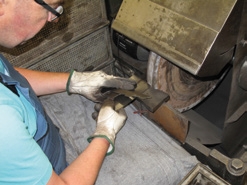
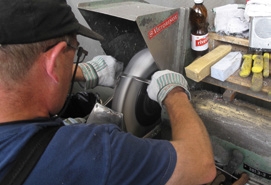
Largest knife factory in Europe
Today, Victorinox employs a headcount of 900 people at the headquarters, around 75% of whom work in the production department. In the light of over 100,000 officer’s knives pocketknives, household, kitchen and professional knives that are produced here daily and the in some cases 400 to 500 working steps that are necessary to produce a Swiss Army Knife, in spite of the high degree of automation a lot of helping hands are needed. All of the working steps are united under one roof. “We only use high quality steel produced in Germany or France, which is quality controlled here and stored in rolls or as strips,” reported Schorno. “We have specialised in the punching out of knife blades, i.e. at Victorinox the blades are not forged, but in fact punched out of a 3 mm thick steel strip and then rounded off using pyramid shaped grinding tools.“ The next step is very important: precisely grinding the blade down very flat so that it doesn’t get caught inside the tool afterwards. The blade is hallmarked with the Victorinox seal and then hardened in the furnace, in order to guarantee a long service life. The blades are lent their legendary sharpness using a process that the company developed itself. The shell case is also manufactured in-house on own injection moulding machines, the significant white cross is applied using the pad-printing method. Then, the knives are assembled using an as far as possible automated process. “We work with around 800 machines in total,” Schorno reported. “Around a third of these machines are standard products, a third of them were further developed to suit our needs and the remaining third are own designs.”
Thus, Victorinox operates completely autarkic and disposes of its own, ultramodern machine and tool building department that is equipped with CNC machines and robotics. This flexibility, paired with century-old knowhow in the production of knives, secures a cutting edge, which Victorinox also intends to retain long-term by training the younger generation. The company employs around 50 apprentices in seven professions, including polymechanic technicians and automation engineers.
Investments for the environment
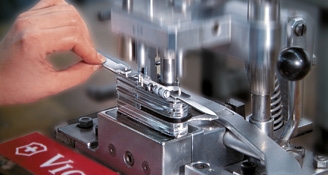
Assembly of the knives: The actual characteristic feature of the Victorinox multitools is that several tools are connected by just one spring.
The company is also committed to environmental protection and initiated an ecology programme in the year 1980 to reduce its consumption of natural resources down to a minimum. “We need around 2,500 t of steel every year,” confirmed Schorno. “However, we source around a fifth of it, namely approx. 500 t, from our recycling plant for grinding sludge that we installed in 1990.” Furthermore, the waste heat from the manufacturing process is used to heat the production sites and the surrounding flats. This – in connection with a sophisticated ventilation and cooling concept – ensures that the entire production only uses as much heating oil a year as a single family home. An integral waste management concept for liquids and solids, the separation of the materials, the sensitization of the employees for environmentally-friendly conduct or the installation of ultra-modern windows have constantly improved the environmental balance.
Further business areas
The high standards that are set for the knife production in Ibach also apply for the other product areas. In addition to the knives, the watches and the perfume are also manufactured in Swit-zerland. The production of the travel gear and the clothes takes place in the Far East because they possess the necessary know-how, whereby high standards are also a matter of course here regarding quality, environmental protection and social responsibility. Within the last decade, the overall turnover has increased from around 375 mil. Swiss Francs (approx. 343 mil. Euros) in 2004 up to around 500 mil. Swiss Francs (approx. 465 mil. Euros) in 2014 – also due to acquisitions, for example the take-over of Victorinox’s former competitor, Wenger. Whereas together perfume and textiles make up approx. 10% of the turnover, watches and travel gear account for approx. 15%. 20% is earned with professional and household knives, the lion’s share of 40% is still made with pocketknives and multitools.
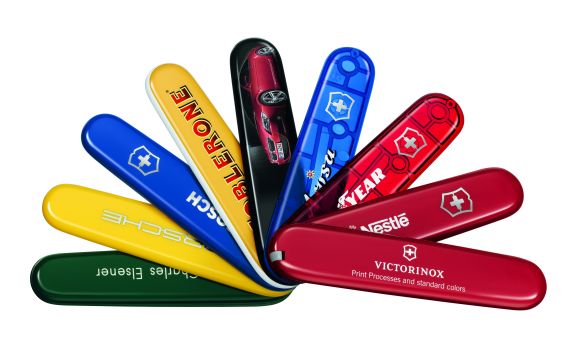
Almost all top brands in Switzerland and three quarters of the leading brands worldwide have already implemented a Victorinox pocketknife as a promotional product before.
Promotional products of high esteem
The B2B business accounts for a stately 30% of the turnover with pocketknives and multitools, so the sector is attributed great significance within the company. Steiner has a team of 17 employees, who are responsible for the acquisition and punctual processing of the orders in the promotional products area. Victorinox has been a member of the PSI since 1995. According to an internal investigation, 97% of the top 100 brands in Switzerland and 76% of the most famous international brands have already implemented a Victorinox product before. But not only the big players, also small companies quickly find what they are looking for among the wide product range – around 900 products are available. Thanks to the many in-house individualisation possibilities, promoting companies have a host of options to impressively present their logo, CI and message. For example, the shell colours of the multitools can be selected in the corporate colours of the company and can be individualised with a pad or photo print. Embossings, diamond engravings or customer-specific packaging are also available. “The blade etching is a particularly elegant customising option,” reported Schorno.
Promoting companies leave behind a longlasting impression, because not only the knives, but also the advertising messages are extremely durable. “The knives are often implemented across generations. So, ideally the advertising message also has to remain intact for 40 years or more,” emphasised Steiner. The knives thus advance into becoming real friends for life. To make sure this doesn’t change, Steiner takes a small repair set with him to every trade fair that he exhibits at, so that he can repair any possible small defects. This delights the fans and is totally in line with the company’s philosophy. After all, the company wants many other Victorinox users to write their own stories.



